As background to the subject of how MIG can help to stabilize herbage quality, recognize first that the nutritional value of pasture herbage reflects not simply nutrient content and digestibility, measured through such indices as crude protein content (CP) or fractions thereof, acid and neutral detergent fiber (ADF and NDF, respectively), total digestible nutrients (TDN), in vitro dry matter digestibility (IVDMD), and the balance among key micronutrients, but also intake, which would be affected by both preference and accessibility within the standing sward profile.
Because the several components of nutritional value are known to vary in response to environmental, managerial, and genetic factors, producers accustomed to the security of feed testing and ration balancing in confinement systems may find the notion of variation in pasture nutritional quality unsettling or even unacceptable. This is one reason why pasture is today seen more as a vehicle for herd exercise, health, and cleanliness than a source of nutrition in most Canadian dairy operations. However, competing producers in grassland-based nations such as the U.K. and N.Z., and more recently, in neighbouring states in the U.S., have found ways to manage or at least live with variability in the nutritional value of pasture herbage. Because feedstuffs typically account for 50 to 60% of the dairy enterprise budget, and with the cost of pasture nutrition being but a fraction of that for conserved feeds (5), farsighted Canadian producers are starting to take a second look at MIG to increase competitiveness in the new global marketing structures.
This paper will briefly review several key factors influencing nutritional value of pasture herbage, and will then consider some practical methods of stabilizing both growth and nutritional value of pasture herbage, particularly in midseason and in the fall. Contrary to expectation, grazing management will be shown to be more important than species selection in maintaining the nutritional quality of pasture swards. Evidence from a survey of commercial dairies in New England (6) will demonstrate that nutritional quality can be sustained, and that pasture can be a viable option, on commercial dairy operations today.
Factors Influencing Variation in Nutritional Quality
Nutritional quality of temperate pasture species is expected to change seasonally, with highest quality in the cooler spring and fall months, and lowest quality being associated with reproductive growth in late spring or early summer. Reproductive growth in temperate grasses is associated with stem elongation, which serves to elevate the reproductive apex into the air to facilitate wind pollination. The leaf:stem ratio declines as stems account for a larger and larger fraction of the sward. However, stems are of lower quality than leaves (8), in legumes as well as grasses. Stems are also less preferred than leaves. Thus, from the perspective of both nutritional quality and intake, a key goal of controlled grazing is to minimize reproductive growth and stem elongation, while encouraging vigorous vegetative growth. Unless reproductive growth is controlled by timely grazing, both nutritional quality and preference to grazing stock typically show a definite decline in midseason.
However, good grazing management can moderate seasonal swings in pasture quality by maintaining the sward in a young and juvenile condition. Data from the Northfork study at Elora, Ontario (4) are representative of the seasonal changes expected in IVDMD, CP, and TDN in a well managed, rotationally grazed pasture sward. The potentially much larger amplitude variation that might be expected on most pastures was minimized by employing MIG with specified sward entry and exit heights. Sward height has been found to be a practical and effective means of regulating grazing for different classes of livestock.
Unpredictable
Of perhaps greater concern to producers are the unpredictable changes in quality which may occur due to weather, and specifically to temperature. For example, Casler (1) compared in vitro digestibility of various fiber fractions in two groups of bromegrass clones which had been pre-selected for high and low IVDMD. In two years, the same clones were transplanted out to adjoining fields and were grown and harvested identically, from which one might expect to see a consistent performance between the two years. The high- and low-IVDMD groups did indeed differ in digestibility of the various fiber fractions, as expected, but differences between years were just about as large as the genetic differences he was eliciting. Even with both genetics and management controlled by the study protocol, unspecified year-to-year variation in the local environment caused just as large a change in IVDMD as the genetic effects that were the object of the study. From the perspective of a producer, unpredictable, environmentally induced changes in nutritional quality are of more concern than predictable, seasonal swings, simply because they cannot be readily anticipated and adjusted for.
Managing Grazing to Stabilize Nutritional Value
Developmental status or maturity of the plant tissues plays the pivotal role in determining the nutritional value of pasture herbage. Because nutritional value is highest in young, juvenile, vegetative swards, a central objective of MIG for milking herds is to keep the sward young by keeping it short. A short entry height confers additional benefits in minimizing trampling losses, stimulating regrowth, and increasing per hectare milk yield. In some nations, this is done with controlled continuous grazing intended to maintain a pre-determined sward height. However, rotational or strip grazing appears best suited to most North American dairy operations, at least for the present.
Achieving consistent rotational sward entry heights of no more than 15 or at most 20 cm is not a simple matter, because pasture swards grow roughly twice as fast in spring as in summer. This means that a given paddock will be able to support roughly twice the grazing pressure in spring as in summer, yet herd demand is typically relatively constant over the season. Compensating for the seasonal imbalance between herbage supply and demand requires a flexible and fluid approach to both the pasture land base and grazing density.
Principles versus Practice
In principle, the spring excess may be conserved as hay or silage, or grazed off by "shortkeep" stock such as dry cows or replacement heifers applied to boost spring grazing pressure. Similarly, the midseason deficit period may be accommodated by introducing hayland aftermath into the grazing rotation or by reducing stocking pressure, or by increasing supplemental feeding. The difficulty of applying these principles in practice, however, results from the seasonal vagaries of the weather. In a good year, perhaps half of the grazed area may need to be harvested at least once to maintain a suitable balance between supply and demand. In a year with a cool, late spring or a protracted early summer drought, the area to be harvested may be only one-quarter or less of the total. The decision on how much land should be harvested, and when, requires judgment which can be founded only upon experience with the particular land and sward. Thus, to perhaps a greater degree than most other cropping "technologies", the practice of MIG is not amenable to recipes or general, regional recommendations. The principles are the same everywhere, but implementation of the principles demands an involved, observant, and responsive grazier.
Key Decision Points
Difficulties in sustaining the nutritional value of pasture are most often experienced in midseason and when extending the grazing season in the fall. Practical grazing and fertilizer strategies are available to address each of these problematic intervals.
Spring Grazing and Summer Regrowth. Spring grazing management is of central importance not simply to consume and utilize available herbage, but especially, to stimulate the subsequent midseason regrowth upon which herd nutrition depends. It is tempting to blame the "midseason deficit" on drought, and lack of moisture unquestionably limits midseason growth in many parts of Canada. However, sluggish midseason regrowth also results from untimely or inefficient spring defoliation. Allowing the sward to "get ahead" in the spring, such that later-grazed paddocks are leggy and overmature when entered, retards regrowth by shading the stem bases from which new young tillers are emerging. Swards which are kept short (15 to 20 cm) by timely spring grazing support a denser and leafier tiller population and have the potential to regrow faster than swards which have grown to a hayable maturity by the time of first defoliation.
Nitrogen. Fertilizer or manure nitrogen (N) can be strategically applied in early summer, after perhaps two cycles of grazing, to give a needed boost to midseason growth before the onset of midseason stress. Some evidence suggests that growth during drought is limited more by lack of N than by water. While spring N is often ineffectual or even counterproductive, in that it further stimulates growth which is often already excessive, early summer N can be useful if rain is available to wash it down into the profile.
Nitrogen can also be used in late summer to stimulate growth in paddocks intended for fall accumulation or "stockpiling" to support continued grazing into the fall. Rate and timing of N, as well as species suitability for this purpose, have been less well studied in northern environments. Nonetheless, some beef and sheep producers are already employing stockpiled forage to support fall and winter grazing, and it seems a viable approach to lowering year-round feed costs, particularly for stock with a lesser nutrient demand.
Regardless of timing, fertilizer N is probably best applied to existing swards as ammonium nitrate (34-0-0) rather than urea (46-0-0), owing to the tendency of urea to volatilize unless incorporated.
Extending the Grazing Season. Perennial swards can be managed to sustain grazing well into the fall, long after the cattle have been housed on many operations. The key to achieving sustained pasture performance in the fall, when cold has slowed or stopped new growth, is withholding grazing to allow fall accumulation on selected paddocks. This concept is the cornerstone of year-round grazing in places like New Zealand, where contrary to popular perception, the grass doesn't actually "grow" year- round. For several months of the year, growth slows or stops entirely due to cold, yet New Zealand dairies have no barns in which to confine the stock during these months, nor any supply of conserved feedstuffs from which to feed confined stock.
So, what do they live on? High quality, stockpiled pasture herbage, largely perennial ryegrass, is rationed out to maintain the herds. Most NZ dairy herds are dry in the winter months, because about 90% of NZ herds are seasonal rather than year-round producers. To avoid excessive pugging damage during wet soil conditions, herds may be allowed to graze an allotted strip for only an hour or so each day, after which they are returned to the secure footing of a drylot. In addition, part of the winter maintenance ration comes from body condition accumulated during the summer months. Thus, instead of incurring the costs of housing and confinement feeding, NZ dairy operators employ a combination of stockpiling and cow body condition to sustain their herds through the "dead" period of low or no pasture growth. This is one reason why they can produce so cheaply; their grass doesn't grow any better they just utilize it more efficiently. They also start from a different premise rather than increasing income by increasing production (per cow) with energy dense rations, they increase income by reducing costs while maximizing production (per hectare) from grass alone.
Can't be done here? Already is. In addition to a core of Alberta beef producers who already graze year-round, consider the largest dairyman in Wisconsin Charlie Opitz who milks some 1200 cows in his seasonal grass dairy operation. The hundreds of replacement heifers on his operation stay outside year-round, and even the milking cows are housed for only a few months of the year. In both NZ and Wisconsin, however, it is agreed that overwintering stock require shelter from the wind, whether in specially designed windbreaks or in naturally treed land.
Selective Grazing and Sward Height. The nutritional quality of ingested forage
can and usually does differ quite substantially from what is "on offer", particularly if stock
are allowed to leave a residue of 8 to 10 cm. One strategy is to vary residual grazing
height to match the nutritional quality of a pasture sward to the nutritional demands of the
grazing stock.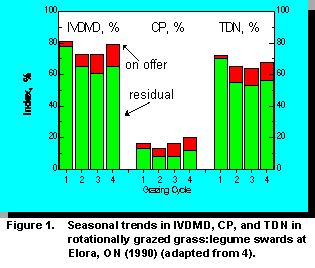
Referring again to the Northfork study of Marshall et al. (4), the levels of IVDMD, CP, and TDN of the herbage on offer differ from those in the residue, and the difference widens toward the end of the season (Figure 1). Clearly, the material ingested under controlled rotational grazing is of higher quality than what would have been estimated from the bulk sward. The difference is most pronounced toward the end of the season, when the calves in this cow-calf trial would be most demanding of high quality nutrition for growth.
The ability of the cattle to "select" higher nutrition occurs because nutritional quality varies vertically within the sward profile, and is generally highest near the top and lowest at the bottom. For example, in swards subjected to rotational grazing with an entry height of 20 to 25 cm, IVDMD in the bottom 5 cm of the sward differed from that in the 5 to 10 cm layer, which in turn differed from that in the 10 to 15 cm layer (Figure 2; 3). Above 10 cm, however, IVDMD was constant among strata. Thus, obliging stock to graze below 10 cm in swards managed in this way would have diluted the quality of the diet. The dilution effect is greater than might be expected as well, because the quantity of herbage also varies within the vertical profile, although in the opposite direction to the nutritional quality of the herbage (3).
Thus, particularly in the fall when bulk nutritional quality may be waning as the bottom of the sward begins to senesce and go dormant, intake of high quality nutrition can be sustained by raising the target residual grazing height. This allows ingestion of highest quality nutrition and sustained animal performance for longer into the fall than could otherwise be achieved. The lesser quality nutrition at the bottom of the sward need not be wasted, however, if a "follower" herd of lesser nutrient demand can be employed to clean up the residue.
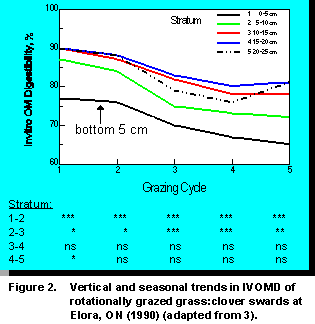
Sown Species
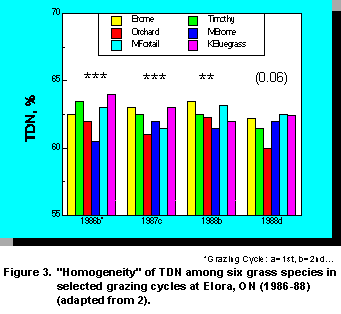 In another Northfork study, Clark and
Buchanan-Smith (2) compared the performance of nine species six grasses and three legumes
under intensive rotational grazing by yearling stockers. Nutritional quality did not differ among
alfalfa, birdsfoot trefoil, and white clover at any harvest. Conversely, at each of several selected
grazing cycles over a three year period, CP, ADF, and TDN differed significantly among the six
grasses, with orchardgrass and meadow brome generally exhibiting poorer nutritional value than
bromegrass, timothy, meadow foxtail, or Kentucky bluegrass when harvested at the same
regrowth intervals (Figure 3).
In another Northfork study, Clark and
Buchanan-Smith (2) compared the performance of nine species six grasses and three legumes
under intensive rotational grazing by yearling stockers. Nutritional quality did not differ among
alfalfa, birdsfoot trefoil, and white clover at any harvest. Conversely, at each of several selected
grazing cycles over a three year period, CP, ADF, and TDN differed significantly among the six
grasses, with orchardgrass and meadow brome generally exhibiting poorer nutritional value than
bromegrass, timothy, meadow foxtail, or Kentucky bluegrass when harvested at the same
regrowth intervals (Figure 3).
However, while significant, the arithmetic differences among species were not large, with just a few percentage points encompassing the range of expression among species. Given that these were bulk samples, it seems unlikely that differences in ingested nutritional quality (see above) among species would have been manifested in differences in animal performance.
The swards sampled by Clark and Buchanan-Smith (2) were young and juvenile, resulting from controlled rotational grazing. Evidence from the literature clearly shows species- specific differences in quality, but in most cases, the differences are recorded in more mature swards or where species were sampled at different stages of maturity. Nutritional data as well as preferential grazing observations (Clark, unpublished) from the above study are consistent with the general finding that species-specific differences in nutritional quality and preference to grazing stock are minimal when compared at a young, juvenile state.
Sown versus Native Swards
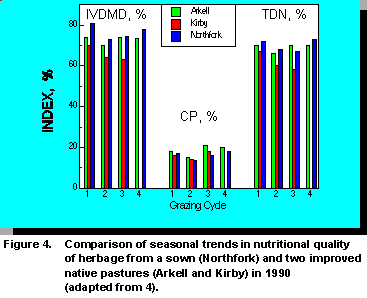 In Ontario, Marshall et al. (4) also
compared nutritional quality indices at the sown Northfork pasture (Elora) with that at improved,
native pastures at Kirby (Elora) and at Arkell (Guelph). Although positioned on very different soil
types, subjected to different fertility regimes, and occupied by quite different mixtures of species,
IVDMD, CP, and TDN indices were very similar across all three rotationally grazed pastures,
when measured in the same year (Figure 4). These findings would suggest that nutritional value
of native species is comparable to that of sown species, when both are subjected to MIG
and are sampled at a young and juvenile state.
In Ontario, Marshall et al. (4) also
compared nutritional quality indices at the sown Northfork pasture (Elora) with that at improved,
native pastures at Kirby (Elora) and at Arkell (Guelph). Although positioned on very different soil
types, subjected to different fertility regimes, and occupied by quite different mixtures of species,
IVDMD, CP, and TDN indices were very similar across all three rotationally grazed pastures,
when measured in the same year (Figure 4). These findings would suggest that nutritional value
of native species is comparable to that of sown species, when both are subjected to MIG
and are sampled at a young and juvenile state.
The consistently high levels of IVDMD, CP, and TDN realized throughout the season at these three diverse pastures supports and amplifies the conclusion above that grazing management can moderate expected seasonal trends in nutritional quality, on native as well as on sown swards.
Dairy Farming in New England
Answers to these questions may be derived from a three-year study involving 34 participating dairy producers in four New England states (6). A total of 545 monthly samples were analyzed both for species composition and nutritional quality. Among the many findings, three will be profiled here.
1. Species composition in the pastures was diverse, with white clover being most prominent, followed by orchardgrass, bluegrass, and timothy. Both alfalfa and red clover, the premier forages for conserved feeds, were a minor component of the pasture swards. Thus, white clover was the legume of choice for pasture, and the diversity of species prevalence suggests no simple mixture accounts for dairy pasture in New England.
2. When plotted in the aggregate -- over 34 farms and 3 years nutritional quality was stable throughout the growing season. Plotting broad averages obscures a great deal of individual farm detail, but more interestingly, it also reveals no seasonal trend in nutritional quality. These producers practiced MIG, with the same kind of practices employed on the research station trials reported above.
3. The realized nutritional quality of the submitted bulk pasture samples was comparable to that of corn silage and superior to that of either hay or silage made from the same pasture herbage (Figure 5).
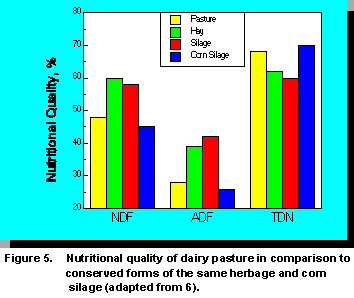
Summary
Research into dairy pasture, while prevalent in the "golden" age of pasture (7), has been largely absent in the subsequent, confinement-intensive era of dairy nutrition and management. However, dairy pasture is now enjoying a resurgence of interest in some parts of Canada as well as in the U.S. Of particular note is the pioneering work of McClelland (5) in Quebec, and Hovingh and colleagues in PEI, both of whom are working actively with dairy producers. Producers in their respective regions will be among the first in Canada to reap the benefits of this new and upcoming research area.
References